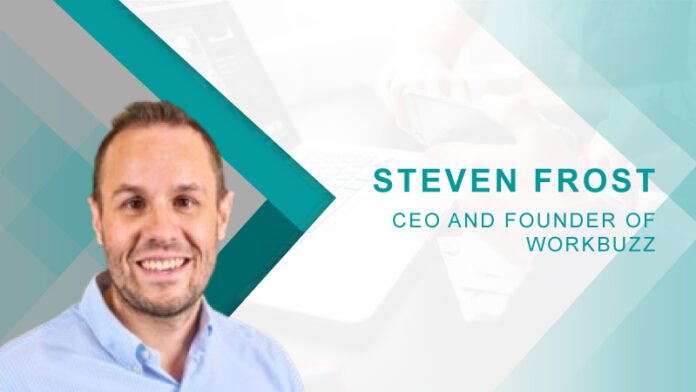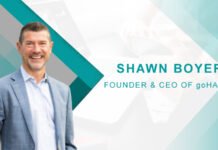Hello Steven, welcome to HRTech Cube. To start, can you please share a bit about your professional journey and what led you to founding WorkBuzz?
After university, I spent six years at a bank where I was introduced to franchising. I thought “Wow! so many big brands franchise” but it was difficult to see how each franchise ranked against their competitors, and which ones delivered on their promises. So I decided to create a program – a bit like Trustpilot – in which I obtained confidential feedback from thousands of franchisees, and used this to recognize the best franchise opportunities, while helping franchises to benchmark and improve. The ‘Best Franchise’ program was born and still runs to this day – last year, 150 of the biggest franchise brands took part.
While running this new program, a number of brands asked if I could also obtain employee feedback to help them to improve employee engagement. As we approached $1 million revenue, I could sense there was an opportunity to do something on a bigger scale: to create a modern employee listening platform, aimed at companies with frontline workers. Frontline workers were all too often an afterthought for tech developers. So I approached an old client, who agreed to invest $380K and WorkBuzz was born! As a non-technical founder, the biggest risk was the tech build, so I hit LinkedIn and had a lot of breakfast meetings before finding the right fractional technology leader – Ivan Izikowitz – who advised me on the tech build.
The last six years have been a rollercoaster. It certainly hasn’t been a straight line but we now have 70 employees (“WorkBuzzers”), raised $11m funding and grown at least 50% every single year. But it feels like we’re just getting started!
Are employee engagement surveys still an effective way to understand workforce sentiment in today’s fast-paced work environment?
The way we listen and engage our people is always evolving and if we think back to a decade ago, most organizations were still relying on an annual survey with rear-view data, often waiting for weeks or months to get their feedback from a research agency. This has all changed thanks to modern employee listening platforms like WorkBuzz. Organizations can now listen more regularly and access real-time feedback and analytics, and so this is a huge a step forward.
What engagement surveys enable you to do is to objectively measure and track your culture, understand what’s working and where to prioritize. Tracking key indicators, like intent to leave, the reasons why employees are looking to leave and how this varies throughout the employee experience, enables leaders to take proactive action before the talent walks out the door.
But what engagement surveys have been lacking is driving change at a manager level. This is where the rubber really meets the road!
What are the biggest challenges HR teams and people managers face when it comes to interpreting and acting on survey results?
The biggest challenge is making sure engagement surveys drive change, otherwise they’re a distraction at best. The key for driving change is line managers but unfortunately most engagement surveys break down at the line manager level. This is because they need support and guidance on how to action the engagement survey feedback. After all, managers have been promoted because they’re good at what they do, not because they’re experts in employee engagement. They can also become overwhelmed by lots of data.
At the same time, many HR teams are often under-resourced, and so are simply too stretched to support line managers effectively. This leads to a double-sided engagement problem!
The impacts are that the survey data crunch doesn’t happen, takes far too long or leads to managers struggling to decipher the results and acting on the feedback. Employees seeing a lack of action following their feedback creates a great deal of frustration.
You’ve mentioned a “double-sided problem” when it comes to engagement surveys. Can you break this down for us?
The double-sided problem has been holding back organizations for decades and is at the heart of why most engagement surveys don’t work. On the one hand, HR teams are often at full capacity so don’t have the time to ‘crunch’ the results from engagement surveys, put together tailored action plans, and then work with each line manager to influence change. And on the flipside, line managers have limited experience of slicing and dicing dashboards, interpreting survey results, and then prioritizing their actions. The outcome is that the survey findings and actions simply fall into a black hole.
How does AI help eliminate these challenges and ensure that engagement insights lead to real action?
AI can improve employee engagement levels through totally eliminating the ‘survey crunch’ and serving-up tailored actions for each line manager in a simple, digestible format. Our People Science AI has been developed to do just this. And so, as soon as an engagement survey closes, the results are instantly analyzed and the key findings pulled out by AI – all within seconds. The results are then delivered to HR, the executive team and line managers in a way that’s tailored to them.
Can you walk us through how WorkBuzz’s AI-powered survey solution works and how it tailors insights to different audiences?
At WorkBuzz, we’ve studied what our best employee engagement consultants do – how they story tell, summarize feedback and the psychology of how this is delivered – and we’ve used all this expertise to develop People Science AI.
Our AI analyzes the engagement survey results including the open-text comments and then delivers customized, bite-sized feedback. This feedback provides a 360 view of what their people are saying and feeling, and drills into the particular elements that are driving engagement for their teams. The bite-size summaries are shared in engaging ways – through video and digestible chunks – and the AI coaches managers on how to have better conversations with their teams in order to bring about meaningful change.
What impact have you seen from organizations using AI to enhance their employee engagement strategies?
It’s still early days, but we’re already seeing how our People Science AI is helping managers to join-up the dots between the survey results and how they can influence change among their teams. We’re seeing managers having better quality conversations with their people to deliver better engagement while avoiding rookie mistakes, like simply focusing on improving hygiene factors, such as pay.
Looking ahead, how do you see AI evolving in the employee engagement space?
We’ll see employee listening evolve more in the next three years than it has in the last 30, with large language models (LLMs) completely transforming how we listen to our people at scale, and at a much deeper level. Interactions with employees will become even more conversational and natural, and we’re going to see a shift away from traditional surveys packed with Likert scales. The way employee feedback is provided will become much more engaging itself, with greater use of conversational bots and videos.
As AI-driven sentiment analysis becomes more common, businesses must navigate ethical concerns, particularly around employee privacy. For example, under California’s CCPA (California Consumer Privacy Act), employees must be informed if their data—including Slack and email communications—is being analyzed. Organizations must ensure AI is used transparently and responsibly to maintain trust.
From your perspective, what’s one strategy business leaders should adopt to drive meaningful engagement in their teams?
Regardless of how AI develops, the recipe for engaging people still remains the same and it boils down to good leadership. It’s about having a clear vision and purpose and showing you have a plan. It’s about getting your recruitment right and prioritizing cultural fit so the right people are on the bus. And it’s about leading from the front; showing empathy; breaking down barriers to ensure frontline workers can do a great job; being visible; role modelling your values; giving employees a voice; and proactively leading your people through change in a world where change can happen daily.
Finally, what’s one key piece of advice you’d give to HR professionals looking to transform their engagement approach?
AI creates a platform for HR leaders to show what it can do. So pioneer, be proactive and lead the business forward, rather than wait to be disrupted.

Steven Frost ,CEO and Founder of WorkBuzz
Steven Frost is the CEO and Founder of WorkBuzz, an employee engagement specialist focused on helping organizations create cultures where every voice matters and every person can be their best. He launched WorkBuzz in 2018, and in 2023 was named in the Top 101 Employee Engagement Global Influencers. Prior to WorkBuzz, Steven ran employee engagement consultancy, Smith & Henderson.












